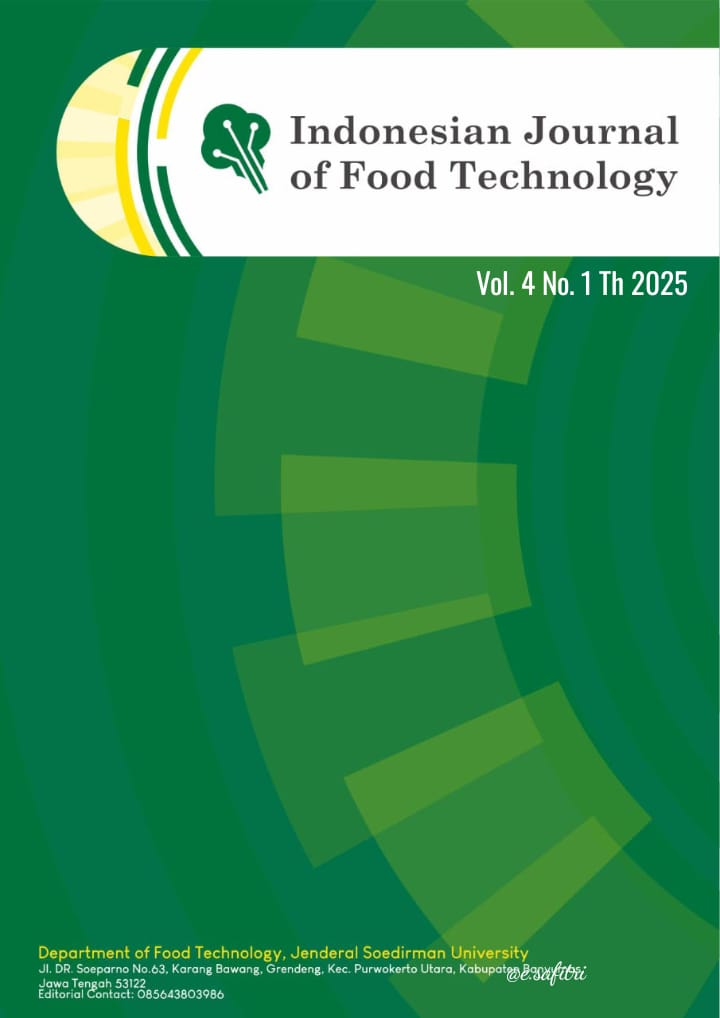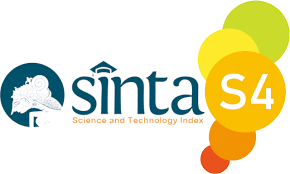Effect of Extraction Time Microwave-Assisted Solvent Extraction (MASE) Method on Decaffeination of Robusta Coffee (Coffea canephora) Java Ijen
Abstract
Java Ijen robusta coffee is one of the potential coffee types to be developed as a low-caffeine product for sensitive consumers. The decaffeination process aims to reduce caffeine levels without eliminating the sensory characteristics of coffee. This study aims to determine the effect of variation in extraction time using the Microwave-Assisted Solvent Extraction (MASE) method on caffeine recovery, chlorogenic acid content, and organoleptic quality of coffee drinks. The extraction process uses water solvent and microwave power of 450 watts with time variations R1 = 4 minutes, R2 = 8 minutes, R3 = 12 minutes, R4 = 16 minutes, and R5 = 20 minutes. Analysis of caffeine content was carried out using a UV-Vis spectrophotometer, while chlorogenic acid content was determined by the titration method. Organoleptic assessment included colour, acidity and aroma attributes by 25 untrained panelists using median scores. The results showed that extraction time significantly affected caffeine recovery and chlorogenic acid content. The highest caffeine recovery of 57.34% and chlorogenic acid content of 19.19% were obtained at an extraction time of 20 minutes. The most preferred colour and acidity were also found in the 20-minute treatment, while the best aroma was at 12 minutes. Increasing extraction time increased colour intensity, acidity, and caffeine and chlorogenic acid concentrations. These results demonstrate the potential of the MASE method as an efficient alternative in decaffeinating robusta coffee while maintaining sensory quality.
References
Cameron, M. I., Morisco, D., Hofstetter, D., Uman, E., Wilkinson, J., Kennedy, Z. C., Fontenot, S. A., Lee, W. T., Hendon, C. H., & Foster, J. M. (2020). Systematically improving espresso: insights from mathematical modeling and experiment. Matter, 2(3), 631–648. https://doi.org/10.1016/j.matt.2019.12.019
Chemat, F., Vian, M. A., & Cravotto, G. (2012). Green extraction of natural products: concept and principles. International Journal of Molecular Sciences, 13(7), 8615–8627. https://doi.org/10.3390/ijms13078615
Daniswara, E. F., Rohadi, T. I., & Mahfud, M. (2017). Ekstraksi minyak akar wangi dengan metode microwave hydrodistillation dan soxhlet extraction. Jurnal Teknik ITS, 6(2). https://doi.org/10.12962/j23373539.v6i2.24483
Demissie, E. G., Girma W., W., & Arayaselassie, A. (2016). Scientific study & research. chemistry & chemical engineering, biotechnology, food industry. Scientific Study & Research Chemistry & Chemical Engineering, Biotechnology, Food Industry, 17(2), 109–123. https://doi.org/10.29081/chiba
Guglielmetti, A., D’Ignoti, V., Ghirardello, D., Belviso, S., & Zeppa, G. (2017). Optimisation of ultrasound and microwave-assisted extraction of caffeoylquinic acids and caffeine from coffee silverskin using response surface methodology. Italian Journal of Food Science, 29(3). https://doi.org/10.14674/IJFS-727
Hanafiah, K. A. (2012). Rancangan percobaan: Teori dan aplikasi (Ed. 3). Rajawali Pers.
Hidayat, P. A. N. P., Puspawati, G. A. K. D., & Yusasrini, N. L. A. (2022). Pengaruh waktu dan daya microwave pada metode microwave assisted extraction (MAE)Terhadap aktivitas antioksidan dan pigmen ekstrak daun ubi kayu (Manihot Utilissima Pohl.). Jurnal Ilmu dan Teknologi Pangan (ITEPA), 11(1), 134. https://doi.org/10.24843/itepa.2022.v11.i01.p14
Kamiyama, M., Moon, J.-K., Jang, H. W., & Shibamoto, T. (2015). Role of degradation products of chlorogenic acid in the antioxidant activity of roasted coffee. Journal of Agricultural and Food Chemistry, 63(7), 1996–2005. https://doi.org/10.1021/jf5060563
Kasman, R. A. & Imranah. (2023). Analisis kadar kafein dan asam klorogenat dalam kopi dengan metode spektrofotometri uv-vis. Jurnal Riset Guru Indonesia, 2(1), 40–47. https://doi.org/10.62388/jrgi.v2i1.213
Lopes, G. R., Passos, C. P., Rodrigues, C., Teixeira, J. A., & Coimbra, M. A. (2020). Impact of microwave-assisted extraction on roasted coffee carbohydrates, caffeine, chlorogenic acids and coloured compounds. Food Research International, 129, 108864. https://doi.org/10.1016/j.foodres.2019.108864
Mardiana, R., Shidiq, S. S., Widiastuti, E., & Hariyadi, T. (2021). Pengaruh suhu roasting terhadap perubahan kadar lemak, kadar asam total, dan morfologi mikrostruktural kopi robusta. Prosiding The 12th Industrial Research Workshop and National Seminar, 12, 151–156.
Marthia, N. (2021). Pemisahan kafein dengan metode microwave assisted extraction (MAE) terhadap 4 jenis biji kopi robusta. Pasundan Food Technology Journal, 8(2), 51–55. https://doi.org/10.23969/pftj.v8i2.4172
Nour, A. H., Hamid Nour, A., Ruth Oluwaseun, A., Suliman Omer, M., & Ahmed, N. (2021). Microwave-assisted extraction of bioactive compounds (review). IntechOpen. https://doi.org/10.5772/intechopen.96092
Pramono, Y. B., & Nurwantoro, N. (2019). Evaluasi kadar gula, kadar air, kadar asam dan ph pada pembuatan tablet effervescent buah nangka. Jurnal Teknologi Pangan, 3(1), 36–41. https://doi.org/10.14710/jtp.2019.20519
Rohmah, A. (2020). Pengaruh ukuran bubuk dan lama ekstraksi terhadap warna ekstrak, kadar fenolik total, dan aktivitas antioksidan pada kopi Arabika dan Robusta dengan metode cold brew [Skripsi]. Universitas Gajah Mada.
Routray, W., & Orsat, V. (2012). Microwave-assisted extraction of flavonoids: a review. Food and Bioprocess Technology, 5(2), 409–424. https://doi.org/10.1007/s11947-011-0573-z
Savić, I. M., Savić Gajić, I. M., & Gajić, D. G. (2024). Optimization of the microwave-assisted extraction of caffeine from roasted coffee beans. Foods, 13(15), 2333. https://doi.org/10.3390/foods13152333
Setiawan, A. A., Imaniar, N., & Rustandi, A. (2025). Analisis kadar asam klorogenat pada ekstrak etanol 96% kulit buah kopi robusta (Coffea canephora) menggunakan spektrofotometri uv-vis. Jurnal Farmamedika (Pharmamedica Journal), 10(1), 61–69. https://doi.org/10.47219/ath.v10i1.419
Severini, C., Ricci, I., Marone, M., Derossi, A., & De Pilli, T. (2015). Changes in the aromatic profile of espresso coffee as a function of the grinding grade and extraction time: A Study by the electronic nose system. Journal of Agricultural and Food Chemistry, 63(8), 2321–2327. https://doi.org/10.1021/jf505691u
Shao, P., Zhang, J. F., Chen, X. X., & Sun, P. L. (2015). Microwave-assisted extraction and purification of chlorogenic acid from by-products of Eucommia Ulmoides Oliver and its potential anti-tumor activity. Journal of Food Science and Technology, 52(8), 4925–4934. https://doi.org/10.1007/s13197-014-1571-8
Sirwutubun, M., Ludong, M. M., & Rawung, D. (2016). Pengaruh konsentrasi etanol terhadap karakteristik ekstrak pewarna alami buah merah (Pandanus conoideus Lamk.) Dan aplikasinya pada produk pangan. COCOS, 7(5).
Sun, Y., Zhang, M., & Fang, Z. (2020). Efficient physical extraction of active constituents from edible fungi and their potential bioactivities: A review. Trends in Food Science & Technology, 105, 468–482. https://doi.org/10.1016/j.tifs.2019.02.026
Swara, I. M. A. B., Puspawati, G. A. K. D., & Widarta, I. W. R. (2023). Pengaruh waktu ekstraksi dengan metode microwave assisted extraction (MAE) terhadap aktivitas antioksidan ekstrak daun belimbing wuluh (Averrhoa Bilimbi L.). Jurnal Ilmu dan Teknologi Pangan (ITEPA), 12(4), 939. https://doi.org/10.24843/itepa.2023.v12.i04.p14
Syafutri, M. I., Pratama, F., & Yanda, G. P. (2019). Sifat fisikokimia zat pewarna dari bunga eceng gondok (Eichhornia crassipes) yang diekstrak dengan metode microwave asissted extraction (MAE). Jurnal Lahan Suboptimal : Journal of Suboptimal Lands, 8(1), 94–106. https://doi.org/10.33230/jlso.8.1.2019.417
Virhananda, M. R. P., Suroso, E., Nurainy, F., & Satyajaya, W. (2022). Analisis kadar asam klorogenat dan kafein berdasarkan perbedaan lokasi penanaman dan suhu roasting pada kopi robusta (C. canephora Pierre). Jurnal Agroindustri Berkelanjutan, 1(2), 245–252. http://dx.doi.org/10.23960/jab.v1i2.6361
Wijaya, D. R., Paramitha, M., & Putri, N. P. (2019). Ekstraksi oleoresin jahe gajah (Zingiber officinale var. Officinarum) dengan metode sokletasi. Jurnal Konversi, 8(1), 9–16.
Wong, J. C. J., & Nillian, E. (2023). Microwave‐assisted extraction of bioactive compounds from Sarawak Liberica sp. coffee pulp: Statistical optimization and comparison with conventional methods. Food Science & Nutrition, 11(9), 5364–5378. https://doi.org/10.1002/fsn3.3494











